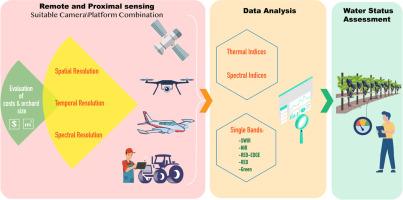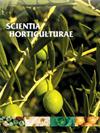通过遥感和近距离传感评估葡萄水分状况的最新进展:综述
IF 3.9
2区 农林科学
Q1 HORTICULTURE
引用次数: 0
摘要
根据现代精准农业原理,遥感和近距离传感是葡萄栽培可持续水资源管理的非常有用的工具。我们阅读了 100 多篇论文并进行了编目,以概述监测不同地区不同酿酒葡萄品种水分状况的最有效方法(包括平台、相机、指数、单波段和统计方法)。卫星和飞机可以监测区域或更大范围内的区域;但是,卫星图像可以免费提供,而飞机图像则较为昂贵。卫星平台的使用前景尤为广阔,尤其是最近在提高空间和时间分辨率方面取得了技术进步。此外,配备热像仪、多光谱相机和高光谱相机的无人驾驶飞行器(又称无人机)也取得了卓越的成果。近距离热像仪和光谱相机(如手持式或安装在拖拉机上的)可以作为一种廉价的替代方法,但往往存在与传统方法类似的问题(如耗时)。热指数(如作物水分胁迫指数)和机器学习算法(ML)在无人机或卫星平台上搭载的高光谱或多光谱相机获得的单个波段和指数上的应用取得了最佳效果。本文章由计算机程序翻译,如有差异,请以英文原文为准。

Recent progress on grapevine water status assessment through remote and proximal sensing: A review
According to modern precision agriculture principles, remote and proximal sensing can be extraordinarily useful tools for sustainable water resource management in viticulture. More than one hundred papers were read and cataloged to outline the most effective methodology (comprised of platforms, cameras, indices, single bands, and statistical methods) for monitoring water status in different wine grape varieties located in different areas. Satellites and airplanes can monitor areas at the regional or larger scale; however, while satellite images can be free, airplane imagery can be more expensive. The use of satellite platforms is particularly promising, especially due to recent technical progress aimed at improving spatial and temporal resolution. In addition, unmanned aerial vehicles (aka drones) equipped with thermal, multispectral, and hyperspectral cameras have provided excellent results. Proximal thermal and spectral cameras (e.g., handheld or installed in tractors) can be an inexpensive alternative but often present similar problems to traditional methods (e.g., time-consuming). The best results were obtained from thermal indices (e.g., Crop Water Stress Index) and the use of machine learning (ML) algorithms on individual bands and indices obtained with hyperspectral or multispectral cameras carried on drone or satellite platforms.
求助全文
通过发布文献求助,成功后即可免费获取论文全文。
去求助
来源期刊

Scientia Horticulturae
农林科学-园艺
CiteScore
8.60
自引率
4.70%
发文量
796
审稿时长
47 days
期刊介绍:
Scientia Horticulturae is an international journal publishing research related to horticultural crops. Articles in the journal deal with open or protected production of vegetables, fruits, edible fungi and ornamentals under temperate, subtropical and tropical conditions. Papers in related areas (biochemistry, micropropagation, soil science, plant breeding, plant physiology, phytopathology, etc.) are considered, if they contain information of direct significance to horticulture. Papers on the technical aspects of horticulture (engineering, crop processing, storage, transport etc.) are accepted for publication only if they relate directly to the living product. In the case of plantation crops, those yielding a product that may be used fresh (e.g. tropical vegetables, citrus, bananas, and other fruits) will be considered, while those papers describing the processing of the product (e.g. rubber, tobacco, and quinine) will not. The scope of the journal includes all horticultural crops but does not include speciality crops such as, medicinal crops or forestry crops, such as bamboo. Basic molecular studies without any direct application in horticulture will not be considered for this journal.
 求助内容:
求助内容: 应助结果提醒方式:
应助结果提醒方式:


